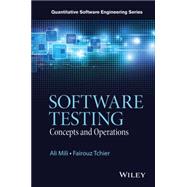Explores and identifies the main issues, concepts, principles and evolution of software testing, including software quality engineering and testing concepts, test data generation, test deployment analysis, and software test management
This book examines the principles, concepts, and processes that are fundamental to the software testing function. This book is divided into five broad parts. Part I introduces software testing in the broader context of software engineering and explores the qualities that testing aims to achieve or ascertain, as well as the lifecycle of software testing. Part II covers mathematical foundations of software testing, which include software specification, program correctness and verification, concepts of software dependability, and a software testing taxonomy. Part III discusses test data generation, specifically, functional criteria and structural criteria. Test oracle design, test driver design, and test outcome analysis is covered in Part IV. Finally, Part V surveys managerial aspects of software testing, including software metrics, software testing tools, and software product line testing.
- Presents software testing, not as an isolated technique, but as part of an integrated discipline of software verification and validation
- Proposes program testing and program correctness verification within the same mathematical model, making it possible to deploy the two techniques in concert, by virtue of the law of diminishing returns
- Defines the concept of a software fault, and the related concept of relative correctness, and shows how relative correctness can be used to characterize monotonic fault removal
- Presents the activity of software testing as a goal oriented activity, and explores how the conduct of the test depends on the selected goal
- Covers all phases of the software testing lifecycle, including test data generation, test oracle design, test driver design, and test outcome analysis








